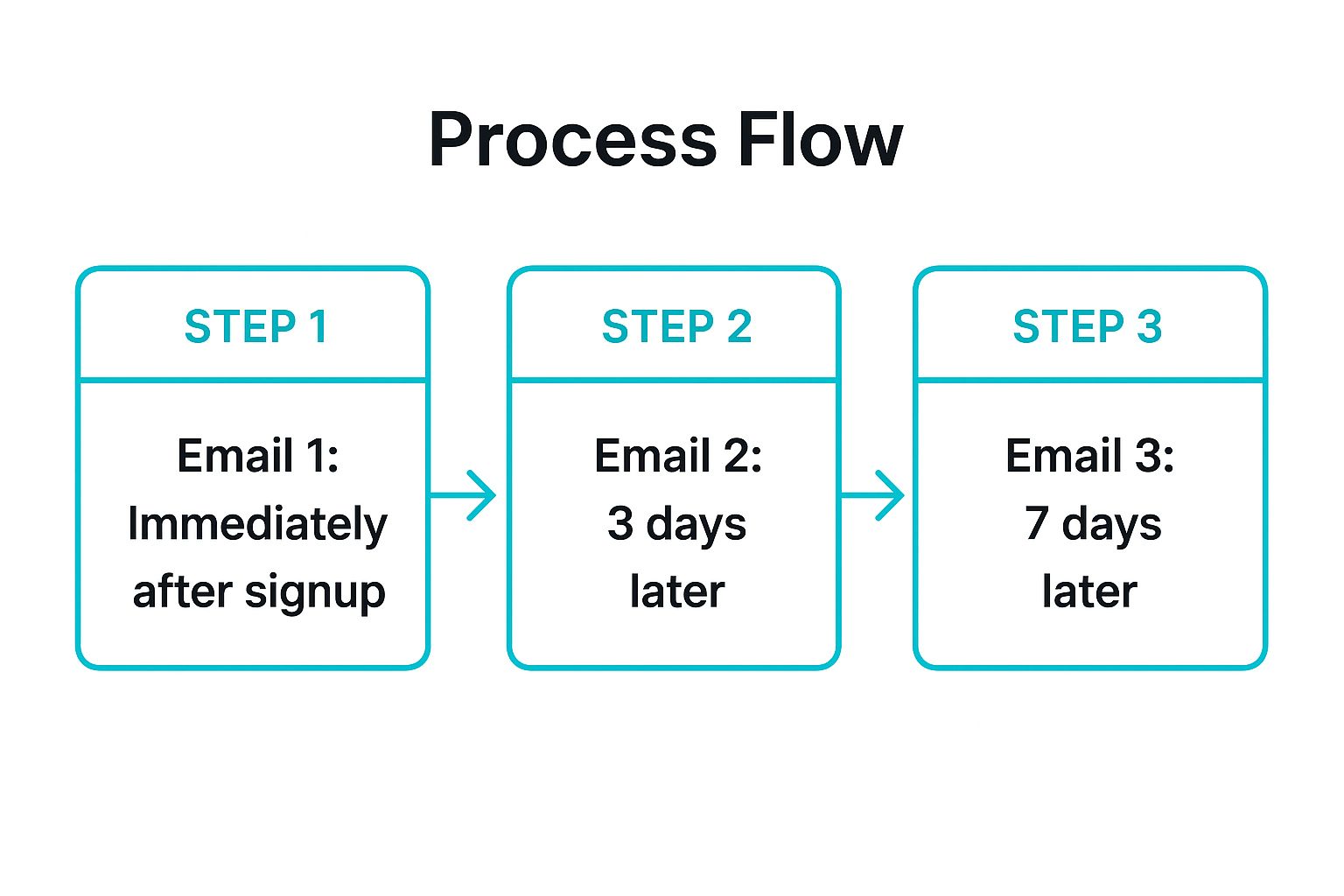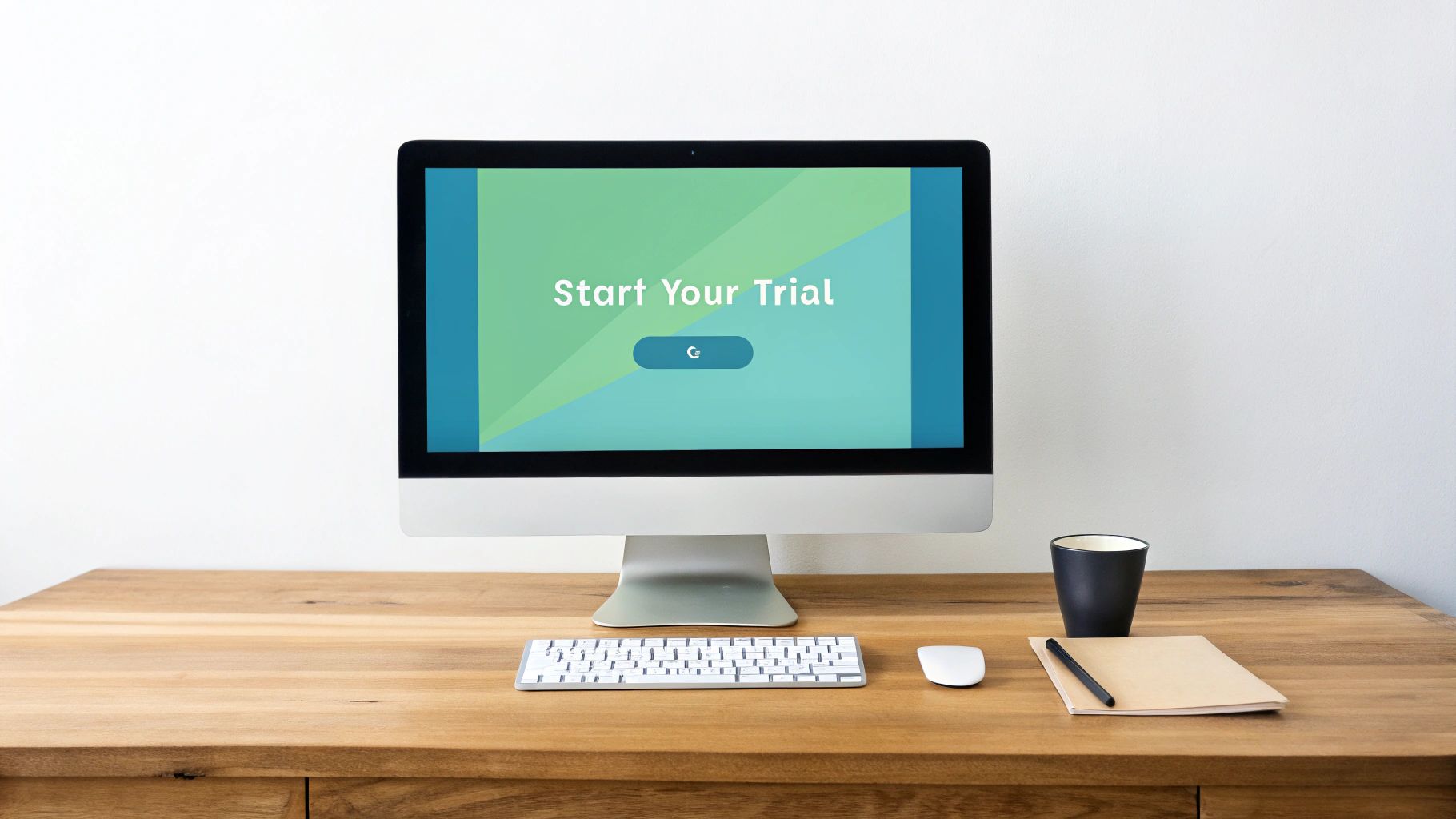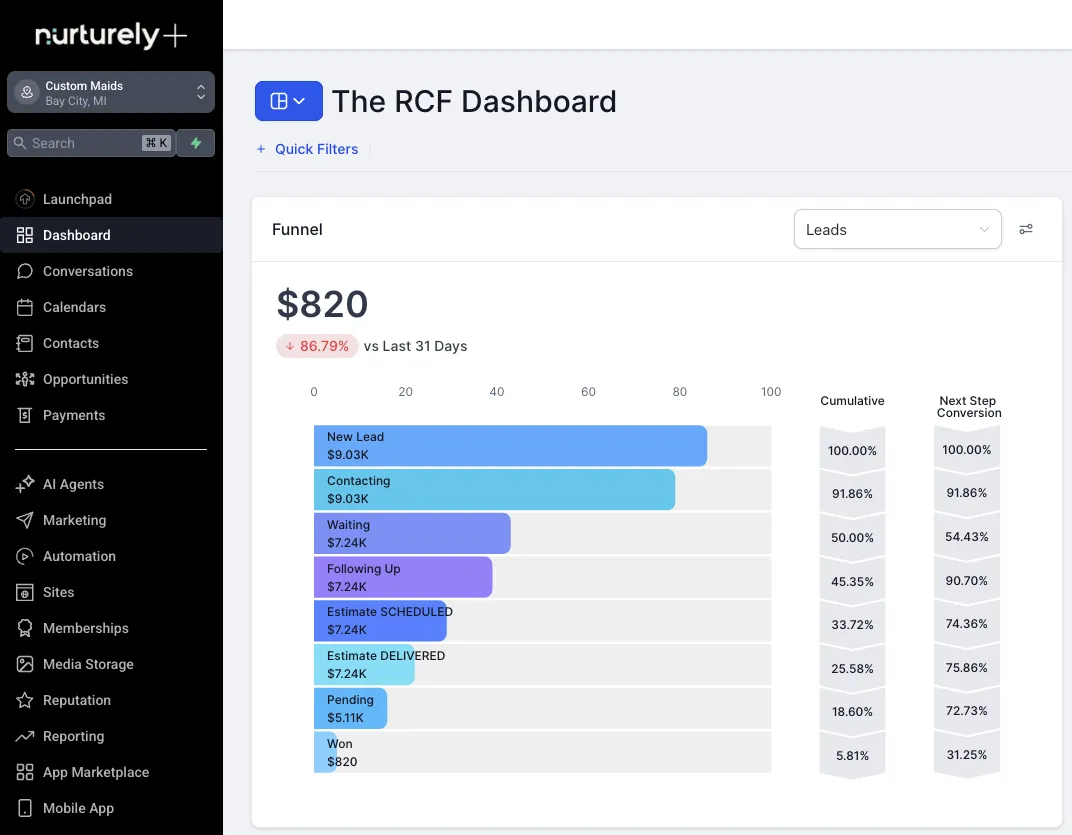7 Incredible Lead Nurturing Email Examples
7 Incredible Lead Nurturing Email Examples for 2025
Acquiring a new lead is only the first step. The real challenge, and where many businesses falter, is turning that initial interest into a paying customer. Without a strategic follow-up plan, a significant portion of your hard-won leads will simply drift away, never to convert. This is where lead nurturing emails become your most powerful asset. They are the automated, personalized conversations that build trust, deliver value, and guide prospects toward a purchase decision when they are ready.

This guide moves beyond theory to provide a practical breakdown of seven powerful lead nurturing email examples. We will analyze each one, from welcome sequences to re-engagement campaigns, providing you with replicable strategies and actionable takeaways. You'll learn not just what to send, but why it works, enabling you to build effective campaigns tailored to your audience. Of course, even the best content is useless if it's never seen. For a deeper dive into getting your messages noticed, explore these strategies to increase email open rates to ensure your nurturing sequences have maximum impact from the very first send.
By the end of this article, you will have a clear blueprint for transforming cold leads into loyal customers. Let's get started.
Table of Contents
7 Incredible Lead Nurturing Email Examples for 2025
3. Product Demo and Trial Series
4. Social proof and Testimonial Series
5. Re-engagement and Win-Back Series
6. Event-Based and Seasonal Campaigns
7. Segmented Persona-Based Campaigns
Lead Nurturing Email Series Comparison
Turn Your Emails into Revenue: Automating Your Nurturing Strategy
1. Welcome Email Series
A welcome email series is your first, best chance to make a strong impression. This automated sequence of 3-5 emails is sent immediately after a potential customer signs up for your newsletter, downloads a guide, or requests a quote. It's the digital equivalent of a firm handshake and a warm introduction, setting the stage for a long-term relationship. This is a foundational tactic in any effective lead nurturing strategy.
The primary goal isn't to make a hard sale right away. Instead, you want to confirm their subscription, introduce your brand's value, and guide them toward the next logical step. For a general contractor, this could mean showcasing a portfolio of finished projects. For an HVAC company, it might involve sharing tips on system maintenance.
Strategic Breakdown
Companies like Slack and Airbnb master this by progressively revealing value. Slack's welcome series doesn't just list features; it walks users through setting up their first channel, inviting a teammate, and sending their first message. Each email builds on the last, turning initial curiosity into active engagement. This method transforms a cold lead into an educated prospect who understands exactly how you can solve their problem.
Key Strategy: The most effective welcome emails focus on education and value first, and sales second. By helping new leads achieve a small win early on, you build trust and demonstrate your expertise.
Actionable Takeaways
Be Immediate: Send the first email within minutes of signup to capitalize on the lead's peak interest.
Set Expectations: Clearly state what kind of emails they will receive from you and how often.
Provide Value: Each email should offer a helpful tip, a useful resource, or a link to a relevant case study. For a landscaping business, the first email could offer a seasonal lawn care checklist.
Personalize: Use the lead's name and reference the specific action they took (e.g., "Thanks for downloading our guide to pest control!").
This infographic outlines a simple yet powerful timing structure for a welcome series.

This paced approach prevents overwhelming the new lead while keeping your brand top-of-mind. For a deeper dive into structuring these initial touchpoints, you can explore this guide to a five-step onboarding process.
2. Educational Content Series
An educational content series is a powerful lead nurturing tactic that focuses on delivering value before asking for a sale. Instead of pushing your product, you send a sequence of emails designed to teach your audience something useful about their challenges. This positions your brand as a trusted expert and builds significant credibility, making the eventual sales pitch feel more like a helpful recommendation than a solicitation.
The goal is to solve your prospect's problems through information. For a roofing contractor, this could be a series on identifying storm damage. A plumbing company might create a series on preventing common leaks. By providing actionable advice, you demonstrate your expertise and build a relationship founded on trust, making it a cornerstone of modern lead nurturing email examples.
Strategic Breakdown
Companies like HubSpot and Moz have perfected this approach. Moz's famous "Whiteboard Friday" series doesn't just sell SEO tools; it teaches complex SEO concepts in an accessible way. Each email provides a valuable lesson, subtly associating that value with the Moz brand. Over time, when a lead decides they need SEO software, Moz is the first name that comes to mind because they've already proven their authority.
Key Strategy: The core principle is to educate, not advertise. By consistently providing high-value, problem-solving content, you move leads through their decision-making process and make your solution the logical conclusion to their educational journey.
Actionable Takeaways
Solve a Specific Pain Point: Center your series around a single, common problem your ideal customer faces. A pest control company could create a 4-part series on "Termite Prevention for Homeowners."
Be Consistent: Deliver your content on a predictable schedule (e.g., every Tuesday) so your audience knows when to expect it.
Include Actionable Advice: Each email should contain a clear, easy-to-implement tip. This gives your leads small wins and reinforces your value.
Introduce Your Solution Naturally: After providing value, you can introduce your service as the next step. For example, "If you've found these tips helpful but want a professional assessment, here's how we can help."
Understanding where this series fits into the buyer's journey is crucial. For more on mapping content to different stages, you can explore the principles of customer journey management.
3. Product Demo and Trial Series
Once a lead shows interest in your specific product or service, the goal shifts from general education to demonstrating tangible value. A product demo or free trial series is a powerful sequence designed to guide prospects through a hands-on experience. It helps them see firsthand how your offering solves their specific problems, making it a critical component of many lead nurturing email examples.
This series is less about telling and more about showing. For a SaaS company like Salesforce, this means guiding a user through setting up their first sales pipeline. For a service business like a pest control company, it could be a "virtual demo" email series showcasing the effectiveness of a treatment method with before-and-after photos and video testimonials. The aim is to convert interest into active engagement and prove your solution's worth.

Strategic Breakdown
Companies like Zoom and Canva excel with this approach. During a trial period, Canva sends design tutorial emails that don't just list features; they inspire action by providing templates for a social media post or business card. This educational content helps users achieve a quick win, making them more likely to see the tool's value and convert to a paid plan. This strategy bridges the gap between understanding a product and experiencing its benefits.
Key Strategy: Focus the trial or demo experience on core "aha!" moments. Guide the user to the one or two key features that deliver the most immediate and recognizable value to solidify their decision.
Actionable Takeaways
Highlight Key Features: Start by showcasing the most impactful features. A general contractor could send a video walkthrough of a recent kitchen remodel, focusing on high-value additions.
Provide Clear Instructions: Give simple, step-by-step guidance. For a lawn care company offering a trial service, an email could outline exactly what the homeowner should expect on treatment day.
Track User Behavior: Use email automation to send personalized follow-ups based on user actions. If a prospect watched a demo video about fence installation, send a follow-up with a case study on a similar project.
Offer Live Support: Make it easy for leads to get help. Include clear calls-to-action to book a call, start a live chat, or speak with a specialist to answer their questions.
4. Social proof and Testimonial Series
A social proof series leverages the power of positive reinforcement to build credibility. By showcasing real-world success stories, glowing testimonials, and detailed case studies, you transition from telling leads you're great to showing them. This type of lead nurturing email example is crucial for building trust, especially for service-based businesses like general contractors or HVAC companies where a proven track record is paramount.

The goal is to help prospects see themselves in your existing customers' successes. When a roofing company lead reads a testimonial from a homeowner in their own neighborhood who praises your quick work and clean job site, it resonates far more than a simple sales pitch. It addresses their potential anxieties and provides relatable, third-party validation.
Strategic Breakdown
Companies like Shopify excel at this by featuring merchant success stories that are both aspirational and relatable. They don't just say, "Our platform helps you sell." Instead, they present a compelling narrative about a real person who built a thriving business, complete with specific challenges and measurable results. This strategy transforms abstract benefits into tangible proof, making the value proposition feel real and achievable.
Key Strategy: The most impactful testimonials connect directly to the prospect's specific pain points or industry. A generic "they did a great job" is weak; a specific "they solved our chronic drainage issue and finished the landscaping project a week ahead of schedule" is powerful.
Actionable Takeaways
Match the Proof to the Prospect: Segment your email list and send case studies relevant to the lead's industry or company size. A pest control business could send a restaurant case study to a commercial kitchen lead.
Quantify the Results: Use specific numbers and metrics whenever possible. Instead of "improved efficiency," use "reduced system downtime by 30% during peak summer months."
Incorporate Visuals: Include high-quality photos or, even better, video testimonials. Seeing the face of a satisfied customer builds a much stronger emotional connection.
Make it Authentic: Use real names, companies, and photos (with permission). Authenticity is the cornerstone of effective social proof.
By strategically deploying testimonials, you alleviate doubt and build a strong foundation of trust, nudging leads closer to a purchasing decision. For more ideas on gathering this kind of powerful content, check out this guide on how to ask for testimonials.
5. Re-engagement and Win-Back Series
A re-engagement and win-back series is a crucial tool for breathing life back into your email list. This targeted campaign is designed for subscribers who have gone dormant, leads who have stopped interacting, or past customers who haven't made a repeat purchase. It’s your opportunity to remind them of your value and rekindle the relationship before they're gone for good. This is a vital, and often overlooked, component of a comprehensive lead nurturing strategy.
The goal isn't just to get an open or a click; it's to understand why they disengaged and provide a compelling reason to return. For a painting company, this might be an exclusive discount for past clients. For an insurance agency, it could be an email highlighting new policy options or a helpful annual review checklist, demonstrating ongoing value.
Strategic Breakdown
Companies like Netflix and Spotify are masters of this art. Netflix sends personalized "We miss you" emails showcasing new shows based on a user's viewing history. Similarly, Spotify uses data to create "Your music is waiting" campaigns, reminding users of artists they love. They don't just say "come back"; they show the user exactly what they're missing, making the offer personal and highly relevant. This turns a generic plea into a specific, valuable invitation.
Key Strategy: Effective re-engagement campaigns combine a touch of nostalgia with a clear, forward-looking value proposition. Acknowledge the absence, then immediately pivot to what's new, improved, or specifically relevant to them now.
Actionable Takeaways
Acknowledge the Gap: Start by recognizing their absence. A simple "It's been a while" shows you've noticed they're gone and you value their presence.
Offer Genuine Value: Provide an exclusive discount, a new valuable resource, or an update on new services. A pest control company could offer a free inspection to a former client.
Ask for Feedback: Include a simple one-click survey asking why they've been inactive. This provides valuable data and can be a part of a larger effort to automate and improve customer support.
Provide a Clean Exit: Always include a clear and easy way to unsubscribe. This respects their choice and helps you maintain a healthy, engaged email list.
6. Event-Based and Seasonal Campaigns
Event-based and seasonal campaigns tap into the calendar to create timely, relevant touchpoints. These emails leverage specific holidays, seasons, or industry events to connect with prospects when their needs are top-of-mind. This approach shows you understand their world and the external factors influencing their decisions, making your message feel less like a generic ad and more like a timely solution.
The goal is to align your value proposition with what's currently happening. For a roofing company, this could mean an email campaign about storm-readiness before the rainy season begins. For a pest control business, it might be a spring campaign focused on preventing termite swarms. This tactic is a powerful part of a complete set of lead nurturing email examples because it adds a layer of urgency and relevance that standard emails can lack.
Strategic Breakdown
Companies like Shopify excel at this by building entire campaigns around key commercial dates. Before Black Friday, they don't just send a reminder; they launch a multi-part series helping merchants prepare their stores, optimize for traffic, and maximize sales. This transforms a simple seasonal promotion into a valuable educational resource, positioning Shopify as an indispensable partner for success. LinkedIn uses the New Year to promote career development courses, perfectly aligning with people's resolutions.
Key Strategy: The most successful event-based campaigns do more than just mention the event. They connect the event directly to a lead’s specific challenges or goals, offering practical advice and solutions that are immediately applicable.
Actionable Takeaways
Plan Ahead: Map out key dates and seasons relevant to your industry and audience at the start of the year. For an HVAC company, this includes preparing campaigns for summer heatwaves and winter freezes months in advance.
Segment Your Audience: Not every event is relevant to every lead. A general contractor might send a "new year, new kitchen" campaign to residential leads while sending a "plan your 2025 budget" email to commercial prospects.
Connect to Value: Don't just slap a pumpkin graphic on your regular email. Explicitly state how your service helps during that specific time. For example, a pressure washing company could frame a fall campaign around "clearing slippery leaf stains before winter."
Use Thematic Design: Incorporate subtle seasonal colors, imagery, and language to make your email visually relevant and engaging without being cliché.
This approach ensures your brand stays pertinent throughout the year, capitalizing on natural cycles of demand. For more ideas on how to tie your services to specific times of the year, check out this guide on seasonal marketing strategies.
7. Segmented Persona-Based Campaigns
Sending the same message to every lead is like a general contractor using only a hammer for every job; it's inefficient and often ineffective. Segmented persona-based campaigns solve this by delivering highly targeted content based on specific buyer personas, firmographics, or behavioral patterns. This personalization goes beyond just a name, speaking directly to the unique challenges and goals of different audience groups.
The core idea is to divide your audience into smaller, more manageable groups and tailor your messaging accordingly. For an HVAC company, this could mean sending one set of emails about residential system efficiency to homeowners and another about commercial maintenance contracts to business owners. This level of relevance dramatically increases engagement and conversion rates, making it one of the most powerful lead nurturing email examples available.
Strategic Breakdown
Companies like HubSpot have perfected this by creating distinct email journeys for different professional roles. A marketing manager receives content about lead generation and ROI, while a sales director gets emails focused on CRM integration and pipeline management. This ensures every piece of communication is valuable to its specific recipient, building authority and trust within each niche.
Key Strategy: The most successful segmentation moves beyond basic demographics. It leverages behavioral data, such as pages visited or content downloaded, to understand a lead's true intent and deliver precisely what they need, when they need it.
Actionable Takeaways
Start Simple: Begin with basic segmentation. A fencing contractor could create separate campaigns for "Privacy Fence" leads versus "Pool Safety Fence" leads based on what they inquired about.
Use Progressive Profiling: Employ forms that ask for one new piece of information over time. This gradually builds a detailed persona without overwhelming the lead with a long initial form.
Tailor the Call-to-Action: The "next step" for a pest control lead interested in termite prevention is different from one concerned with rodent control. Customize your CTAs for each segment.
Track Segment Performance: Analyze which segments respond best to your nurturing. This allows you to refine your personas and double down on what works, optimizing your marketing spend and effort.
By treating different leads differently, you acknowledge their unique needs and position your business as the specialized solution they've been searching for. For a deeper look at creating these personas, explore this step-by-step guide to building buyer personas.
Lead Nurturing Email Series Comparison

Turn Your Emails into Revenue: Automating Your Nurturing Strategy
Throughout this guide, we've dissected a wide array of powerful lead nurturing email examples, moving far beyond generic templates. We've seen how a strategic Welcome Series can set the tone, how Educational Content builds authority, and how Social Proof can dismantle purchasing barriers. The core lesson is clear: effective lead nurturing is a dynamic conversation, not a one-time sales pitch.
The journey from a curious prospect to a loyal customer is built on a series of purposeful touchpoints. Each email type we explored, from the initial greeting to a strategic win-back campaign, plays a critical role in this relationship. The goal is to deliver value, build trust, and demonstrate understanding of your lead's specific needs at every stage.
Key Takeaways for Building High-Converting Sequences
Mastering the art of lead nurturing requires shifting your focus from simply sending emails to architecting intelligent customer journeys. The most successful businesses, from HVAC contractors to veterinary clinics, understand this principle.
Here are the essential strategies to implement:
Map to the Buyer's Journey: Don't send a testimonial email to someone who just signed up. Align your content with their current stage of awareness and consideration, guiding them logically toward a decision. The lead nurturing email examples for re-engagement are vastly different from those in a welcome series for a reason.
Prioritize Value Over Sales: Your primary goal in most nurturing emails is to educate, help, and build rapport. Whether you're a roofer sharing a guide on "5 Signs You Need a Roof Inspection" or a landscaper offering seasonal lawn care tips, this value-first approach builds the trust necessary for an eventual sale.
Segment for Maximum Relevance: Generic, one-size-fits-all emails are a recipe for high unsubscribe rates. Use the data you have, such as the service they inquired about or the content they downloaded, to segment your audience and deliver highly targeted messages that resonate deeply.
Automate to Scale Success: Manually tracking every lead and sending the right email at the right time is an impossible task. Automation is the engine that powers a sophisticated nurturing strategy, ensuring no lead is forgotten and every opportunity is capitalized on.
To fully leverage the power of automated nurturing, a thorough understanding of a comprehensive AI marketing automation guide can provide the foundational knowledge needed to transition from manual setups to scalable, intelligent systems.
Ultimately, the strength of your lead nurturing strategy directly impacts your bottom line. By implementing these proven frameworks, you transform your email list from a simple database into a powerful, automated revenue-generation machine that works for your business 24/7.
Ready to stop manually managing your leads and start automating your growth? Nurturely Plus provides the all-in-one platform to build, automate, and manage every lead nurturing campaign discussed in this article. See how our powerful CRM and marketing automation tools can help you turn more leads into loyal customers. Explore Nurturely Plus today.



